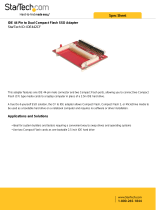Page is loading ...

Addonics IDE DigiDrive Installation
(Model: AEIDEDMD4)
Thank you for purchasing the Addonics IDE DigiDrive. This drive is designed for installing into any PC or Equipment with a standard
3.5’ drive bay and IDE interfaces. The drive works like a floppy device and requires No special driver. Once connected, it can be use
in computer running DOS and all Windows OS.
Hardware Installation
1. Power off the computer
2. Handle the device on the side and avoid touching the circuit board. Slide the IDE DigiDrive into one of the 3.5” drive bay of the
computer and secure the device to the drive bay with mounting screws.
3. Refer to figure 1; connect the IDE cable and the power cable to the IDE DigiDrive, making sure that the cable is plug into the
correct direction (pin 1 should go to pin 1 and so on).
4. Jumper JP1 setting 3,4-master (factory default), 1,2-Slave, and 5,6-cable select.
5. Power on the computer (for DOS machine, make sure there is a Flash media inside one of the slots), the LED light on top left hand
corner of the IDE DigiDrive should lit up. When the operating system is fully loaded, a drive icon labeled as Removable Disk will
appear in the My Computer folder.
Mounting
hole
Power
connecto
r
Master or
slave jumper
LED
IDE
connector
Figure 1
IDE DigiDrive Utility Software
To install this software, load the CD into your computer and run the Setup program from the CD.
N
ote: The IDE Digidrive can operate without the utili
t
y software. The software fixes a bug in win2000 and adds A few user friendly
features:
• Report the proper media capacity under win2000 when switching media (a software bug on win2000 OS)
• Alert users when more than one media is inserted into the drive.
• Icon to show the type of media being detected.
• Format utility to ensure the correct format of different types of media.
• Bootable from CF, SD and MMC-to use this feature, the media must be boot enabled via the IDE Digidrive format utility and the
system BIOS need to be set to boot from the IDE Digidrive.

How to Use
To use, insert your memory card into the appropriate slot into the IDE DigiDrive. From here the card works similar to a floppy disk.
During operation, the LED light flashes when data is read or copied onto the media.
Switching to different media with one drive icon
1. Please note that if you have more than one media in the device, the drive icon will recognize only the media that is inserted first
into the device. To recognize the new media inserted in another slot, the first media must be removed and follow by double
clicking on the drive icon again to reset the device.
2. If you have more than two media inside the device while booting up your computer, the first media that will be detected will be in
the following slot order: Compact Flash, Smart Media, Memory Stick and MMC & SD.
For DOS and Windows NT
When using the device on DOS machine, one of the slots must contain a media during the boot time. Otherwise, no drive letter will appear
under DOS. Switching media to different slot must require system reboot in order to recognize the new media.
Smart Media (SM)
Insert Card with metal contact strip facing down and the cut out notch on the left side going toward the drive.
Push gently all the way in and then release.
To remove the card, merely pull out the media. When more than ¼ inch of the card is showing, you may remove the card safely.
Sony Memory Stick (MS)
Insert Card with metal contact strip facing down and the cut out notch on the left side going toward the drive.
Push gently all the in and then release.
To remove the card, merely pull out the media
Multimedia Card (MMC) or SecureDigital Card (SD)
Insert Card with metal contact strip facing down and the cut out notch on the left side going toward the drive.
Push gently all the in and then release.
To remove the card, merely pull out the media
Compact Flash (CF) or IBM Microdrive
Insert Card with the edge with the holes facing toward the drive, making sure to line the card up with rails.
To remove the card, merely pull out the media
Technical Support
If you need assistance to get your unit functioning properly, please call Addonics Technical Support. Our technical staff will be happy to
assist you, but they will need your help to do so. Calling the technical support staff without all the proper information can be both time
consuming and frustrating. Here are some tips to help you out:
Contact Information
Addonics Technologies
2466 Kruse Drive
San Jose CA, 95131
Phone: 408-433-3855
Fax: 408-433-3898
Email: [email protected]
Addonics Technologies – IDE Digidrive Users Guide v1.0
1
/










